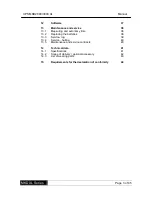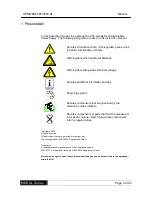
UPS MKD2000/3000 XL
Manual
MKD XL Series
Page 8 of 45
3.4 Connection
Only connect the UPS to an earthed shock-proof socket or, where a terminal
clamp is used, be sure to connect the protective earth conductor. Under no
circumstances should the equipment be operated without a protective earth
conductor.
The house installation socket must be easily accessible and located in the
vicinity of the UPS. In the case of a fixed connection, ensure that the shortest
possible cable lengths are used.
In case of generator mode, there hast o be a polarized connection of the UPS.
Only use VDE-tested and CE-labeled electrical cables to connect the
consumer load to the UPS. In the case of a fixed connection to the consumer
load, a suitable cable must be used.
The fuse protection for the consumer load must always be installed directly in
front of it, and never centrally in front of the UPS.
Do not operate any household appliances and power tools, e.g. fan heaters,
vacuum cleaners, drills, hairdryers, toasters etc., via the UPS.
Do not connect any consumer loads to the UPS which could overload the
equipment (e.g. laser printers).
The sum of the earth fault currents of all consumer loads connected to the UPS
must not exceed 3.5mA.
Keep the connecting cables as short as possible and always lay these
correctly. Avoid the dangers of laying connecting cables in locations where
they may be tripped over, crushed or torn open etc.
3.5 Operation
The mains power cable must never be disconnected during the operation of
the UPS, otherwise the protective earthing of the UPS and the connected
consumer loads will be lost.
Before connecting consumer at the output, the basic configuration (9.2.3) has
to be made. The output voltage with regard to the consumer and the output
frequency during battery service are very important.
The UPS equipment contains an energy accumulator (batteries). This means
that the output of the UPS may be live even if it is not connected on the line
side.
To switch off the UPS completely, first press the switch on the front of the
equipment (OFF position), wait until the UPS has switched off then disconnect
the power supply (switch off the mains input externally or disconnect the UPS
from the mains, e.g. by unplugging it).
Make sure that no fluids or foreign bodies enter the UPS.









































